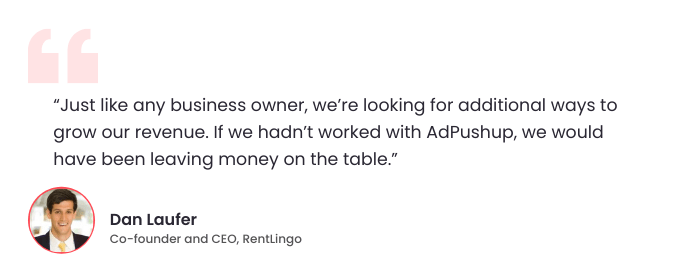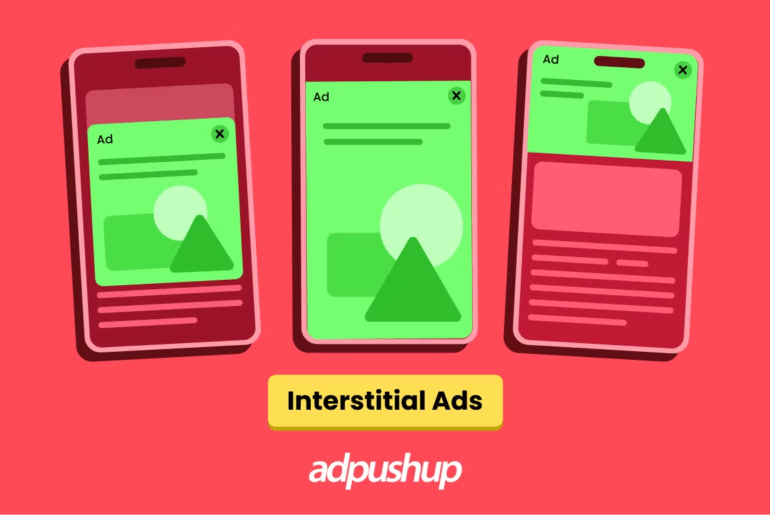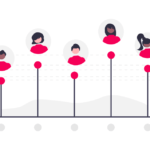The advertising industry is coming up with new ad formats to capture the audience’s attention – and why wouldn’t they? One of the main aims is to drive sales, something that can be easily achieved via interstitial ads. In this blog, we will shed light on interstitial ads – what they are, the controversy surrounding them, their benefits, and alternatives.
Interstitial ads are a great way to catch people’s eye and promote products/services. In fact, games often use a special kind of interstitial ad called playable ads, which can even make players stick around longer. And if you’re a gamer, chances are you’ve seen a lot of these ads—they make up a big chunk of the ads gamers see.
As per the data, interstitial ads make up more than 70% of the ads gamers see. While their click-through rate is high, if not used mindfully, interstitial ads can cause quite a controversy.
That said, let’s now get to the heart of the matter.
What is an Interstitial Ad?
Interstitial ads are full–screen ads that cover the entire display screen of a user to make ads more interactive. These ads work best when appearing between natural transition points or breaks. Interstitial ads can be of different types: text, image, video, and more. Their full coverage attribute makes them different from other ad types like pop-up, native, and banner ads.
Full-screen ads are commonly displayed on mobile devices. However, many desktop websites also show interstitial ads.
Now that you know the interstitial ads definition, let’s explore how it works.
How do Interstitial Ads Work?
As explained above, interstitials appear during organic transitions on a webpage or mobile application. They can appear between game levels, while browsing products online, video streaming, etc. They are seen as intrusive because these ads tend to bypass ad blockers, hence getting penalized by Google.
Interstitial ads have one significant advantage – the user can choose to engage.
In static interstitial ads, the user can choose not to engage by closing the ad. However, with video interstitials, the user must watch the ad for a set duration before the cross option appears.
Depending on where the ad is shown, the duration can range from five seconds to one to two minutes.
What are the Types of Interstitial Ads?
Advertisers experiment with different types of interstitial ad formats to bring more diversity and engage users. Such formats make the ads less intruding and reduce the website bounce rate. Some of them are:
- Full-screen interstitial ads: These ads cover the whole screen while the user is exploring a website, making it impossible to ignore them. They mainly take place during organic transitions to make the ads less intruding.
- Exit intent interstitials: As the name suggests, exit intent interstits appear as a pop-up when a visitor is about to leave a website. E-commerce websites have fully utilized them to increase their conversion rates. These are shown when the user leaves their cart without completing the purchase. The motive is to offer last-minute discounts to complete the payment or present tempting offers to drive sales.
- Video interstitial ads: These ads feature videos to advertise their message. They are quite common on YouTube, travel, and gaming websites.
- Mobile interstitials: These are interstitials that are specifically designed for mobiles. They generally show up during natural transitions while using mobile applications. For example, you might be shown umbrella ads while using the weather app during rain.
- Interactive interstitials: Lastly, interactive interstitials are ads that are specifically created to increase user participation and engagement, as well as collect data for advertising. They are generally in the form of short surveys.

Top 5 Examples of Interstitial Ads
Interstitial advertising can be found on almost all major platforms, including gaming sites, social media, streaming services, and emails.
- Interstitial ads on websites: Many websites use interstitial ads to promote featured content, special offers, subscriptions, webinars, or even sign-ups. This is very common in digital news websites.
- Interstitial ads on social media: These ads are becoming more popular on various social media platforms due to the compelling and unique experiences they offer. For example, Instagram has seamlessly integrated these ads into its story, posts, and reel features. Similarly, SnapChat has also integrated these ads into its Discover feature to deliver captivating content.
- Interstitial ads in streaming services: Interstitial pop-ups have become a common sight in streaming services. The OTT platforms use these ads to achieve two goals – promote premium content, an anticipated show or sponsors, and generate revenue. The best example is Disney+. It cleverly places interstitials between the shows to highlight its exclusive content and create hype to entice users to watch it.
- Interstitial ads in gaming: Game developers extensively use interstitials to promote other games or in-app purchases. Play almost any game, and you will see that at almost every turn, it offers extra rewards, exclusive deals, power-ups, and much more in exchange for watching these ads.
- Interstitial ads in emails: Marketers have started incorporating interstitial pop-ups to make their email advertising efforts more effective. Many clothing brands use these pop-ups to inform their subscribers of limited-time deals, exclusive offers, or flash sales. Interstitials have enabled advertisers to convey their message without bringing users to any website.
Benefits of Interstitial Ads for Publishers
Brands like Pinterest and Airbnb have reported an increase in app installation by 100% and 300%, respectively, by optimizing interstitial ads. Due to this, most publishers tend to include interstitial ads in their ad inventory knowing marketers and advertisers are ready to pay a sizeable amount for interstitial ads.
Here are reasons why publishers should choose interstitial ads:
High click-through rate
With interstitial ads, the users have two options: either to click on the ad to check out the offering or to click on the close button and continue ahead. Facts say, interstitial ads have a higher click-through rate than banner ads.
Compelling and convincing
A user is least likely to be able to avoid an interstitial ad as it covers the entire device screen. Hence publishers can always show high CPM and rich media ads here for a better impact on users.
Solves banner blindness
Because a full-screen ad would be pretty hard to ignore. The user might not ignore the ad displayed on the screen, hence reducing banner blindness.
High Revenue
Interstitial ads are used in high-intensity campaigns where high user engagement is critical. To achieve this goal, advertisers pay a premium for ad inventory. Publishers control the frequency capping, so they can charge a premium for the ad space.
What are the Challenges with Interstitial Ads?
As mentioned at the beginning of the article, interstitials are controversial. While they benefit publishers and advertisers, they can also irritate users.
Some disadvantages of interstitial adverts include:
1. Penalty By Google
The major controversy around interstitials is that Google is penalizing them. The tech giant sees these ads as a disruption to the user experience because they cover the whole screen. Bombarding a webpage with interstitial pop-ups can lead the user to abandon the page, which increases the bounce rate, hindering its main intent—conveying information to the user.
2. Ad Fatigue
You are reading an online review of an upcoming movie but see that ads for booking movie tickets keep appearing. You see them once, twice, or thrice, but on the fourth time, you abandon the page and read on another site. This is what we call ad fatigue.
The best way to tackle ad fatigue is to use frequency capping, where marketers can decide how many times a user will see the interstitial ads to maintain a positive user experience.
Ad fatigue is a phenomenon among internet users in which they lose interest in a website, game, or streaming platform due to the constant popping up of ads. In simple terms, when users see too many similar ads, they get annoyed and become non-receptive to them. User satisfaction tends to decline with overexposure, defeating the main purpose of an ad.
3. Disrupting User Experience
Suppose you are reading your favorite novel online. You see that with every scroll, an ad appears. You will engage with the same ad once, twice, or even thrice. But if these ads keep coming, will you keep reading your online novel? Of Course not!
If not placed strategically, interstitial ads can be a huge turnoff for users visiting your website. The reason? Firstly, users are forced to see them as they pop on their screen out of the blue, and secondly, many interstitial ads have to be seen for a specific duration before the close option appears.
Poorly implemented interstitials can impact the retention rate and disrupt the content flow, leading to dissatisfaction and negative feedback.
4. Slow Loading Time
Due to large graphics and complex elements, interstitial ads can be relatively heavy compared to other ads. This can slow their loading time, affecting the website’s core web vitals.
Heavy files can lead to latency issues, prompting the user to move away from the website and causing revenue loss.
Top 4 Tips to Optimize Interstitial Ads
1. Don’t Hinder With Users’ Tasks
Nobody likes getting interrupted. The same is the case with ads, especially while working on something like filling out a form. Hence, interstitial ads should be avoided between important user activities or interactions. However, if the task is considered unimportant (leisure activities like watching a series) and you want to show an ad there, make sure the ongoing task is paused while the user receives the ad.
2. Allow Appropriate Loading Time For The Ads
Interstitial ads are large-size ads with rich media and heavy graphics. This means These kind of ads will take a good amount of time to load on the users’ screen. Now, you wouldn’t want your users to wait for an ad to load.
Hence, in order to avoid such problems, make sure the ad is rendered quickly. Even better, start loading your ad before it’s called. So when the time comes to display it, it won’t take much time.
3. Do Not Flood Users’ Screen With Ads
This is applicable to all kinds of ads. As in the case of interstitial ads, which cover the entire screen, showing too many ads in a short time interval is most likely going to degrade their user experience and eventually lead to a lower click-through rate (CTR).
4. Make Sure Interstitial Ads Are Right For You
Interstitial ads might sound like a good idea when it comes to getting impressions from users. However, before running them on your platform, make sure you know that these ads are right for you.
As we discussed, interstitial ads work best when placed between transition points; points, when the user is expecting a break. By doing this, the user might take a good look at the ads and click on them. Examine the app or site flow to find the best place and time to display interstitial ads.
Banner Ads vs Interstitial Ads
Banner ads and Interstitials ads are two of the many formats used in programmatic advertising. However, these two ad formats are quite different and are used according to the goals set by the advertiser. Similarly, depending on the website, the publisher can also decide when they want banner ads or interstitials on their website.
Banner ads are the most basic ad format used in advertising. They can be plain or dynamic and appear at the top, bottom, or sides of the webpage. Publishers can also set the ad refresh rate of these ads to maintain their uniqueness. Banner ads are the best option for maintaining a brand’s omnipresence, but they are susceptible to banner blindness, as users can deliberately ignore them, knowing they are ads.
On the contrary, interstitial ads are full-page ads that appear at natural intervals. These ads cover the whole content, compelling the viewer to engage with the ad—either clicking on it or simply closing it. Interstitials are generally used for high-impact campaigns that require the visitor’s full attention.
While banner ads are considered acceptable by users, many can flag interstitials as intrusive advertising, making the website user-unfriendly.
Did you know that Google can penalize advertisers and publishers for using interstitial advertising? Here’s how:
What types of Interstitial Ads are Penalized by Google?
According to Google AdMob interstitial ad policy, Google won’t penalize all interstitial ads, but only those that disrupt the user experience. It laid down certain rules that the advertisers should follow while implementing these ads. The following interstitial adverts will be penalized by Google:
- Ads covering more than half of the screen and breaking the content flow.
- A standalone interstitial advert or full-screen ad that covers the whole content, disrupting user experience.
- These ads that don’t appear distant from the original content on the webpage.
How Google Penalizes Publishers for Interstitial Ads?
There are three ways in which Google will penalize a publisher for overusing interstitial adverts and not following its guidelines:
- A sudden drop in website traffic and search ranking.
- Lower user engagement.
- For mobile apps, reduced visibility or removal of apps (extreme case) from Google Play Store.
How Publishers Can Avoid Getting Penalized
Interstitial ads sound fun. However, if not used properly, penalties can be experienced. The important thing with these ads is timing. They shouldn’t disturb the users and their experience while accessing some important webpage for information or while transacting.
The best and easiest way to avoid penalties on interstitial ads is to check and
One thing to keep in mind, interstitial ads can be annoying on a desktop, so one has got be thoughtful about their use. On the desktop, the display screen is big, and finding the close or continue button becomes a task for the users. On the other hand, with a mobile device, the close button [or X] is too small to locate and tap.
However, many publishers show interstitial ads on the desktop version of their website. Similarly, if you have a method that is working well for your desktop website without getting penalized, you’re in good practice. If not, you should reconsider planning interstitial ads on your desktop web pages.
Even when displaying these ads on mobile devices, you need to make sure the ads are not interrupting the user in any way. They should appear between natural pauses. For instance, an interstitial ad can be displayed after the end of a gaming session or when the user is switching between articles.
Pro tip: If your site or application involves a lot of direct user interaction (like clicks involved while playing Candy Crush), do not put an interstitial ad between those interactions. This may lead to ads getting clicked by a user unintentionally causing an invalid activity. Worse, you’ll just end up hampering your users’ interaction with your website/app, eventually losing them (maybe forever).
Interstitial Ads Penalty Exceptions
Although interstitial ads are not exactly Google’s favorite, there are instances where Google allows and even prefers these ads over other ad formats, such as:
1. Age Verification Interstitial Adverts
If a website hosts adult-related or narcotics-related content, it is encouraged to use interstitial ads as a doorway for age verification and a related disclaimer. In many countries, such interstitials are mandated by law. A whois lookup can provide insights on the ownership of such websites to ensure they comply with these laws.
2. Page-to-Page Interstitials
Google accepts interstitial advertising appearing when users migrate from one page to another within the same website. However, if the webpage is searched organically on Google, no interstitial ads should appear while it opens.
3. Cookie Usage Interstitials
Cookie usage interstitials are a type of interstitial advert that shows up as soon as you land on a website. These ads generally inform a user about using cookies for data collection and require their consent. Many countries have made it mandatory for websites to show interstitial ads explaining their cookie policy to empower the user and give them control over their data.
4. Crossing a Paywall
You will come across many websites that show interstitial paywall ads to entice consumers to pay for their content. This is especially used by media outlets like the Wall Street Journal or National Geographic, which invest money and resources to curate their content.
Can Publishers use Vignette Ads?
Vignette ads and interstitial advertisements are like two sides of the same coin. The only difference is their timing of popping up – interstitials appear at the beginning or in the middle of web browsing. In contrast, vignettes appear when the visitor is leaving the site.
Google has not been clear on whether it will penalize vignette ads similar to interstitial adverts; they do seem to violate Google’s guidelines.
Interscroller Ads: An Alternative To Interstitial Adverts
Interscroller ads are one of the newest ad formats in the advertising world. Many advertisers and publishers have started adopting this trend to minimize the user experience disruption that comes with interstitial ads.
Interscroller ads appear as a scrollable ribbon-like strip within the website. This format allows several ad units to be displayed at the same time, giving advertisers more page area and ad space to work with. It also allows users to see multiple ads at the same time.
Users can go through the content while viewing the ad, and with no interruptions in the content flow, interscroller ads easily comply with the guidelines.
Planning to Add Interstitial Ads?
A study suggested, 22% of users look for the close button as soon as an interstitial ad appears on their screens. However, 40% of users remember the ad and its offer, after experiencing interstitial ads. This means interstitial ads are all about relevancy and timing.
If you are starting out with interstitial ads but don’t know much about them, Google AdMob can be the best way to start out. For mobile application publishers, it is best to read at Google’s guide to integrating interstitial ads.
Lastly, remember testing is the key. Even if you are doing fine with the existing setup, it is always good to try and look out for better methods. The same thing is applied in the case of interstitial ads. Monitor user behavior and advertisers’ response to upgrade your strategies and you shouldn’t miss out on a chance to generate better revenue.
Frequently Asked Questions
A: Interstitial ads are ads that cover the entire content on the user’s screen to increase ad visibility. They generally appear during a transition from one webpage to another.
A: Pop-ups cover a very small portion of the screen, which makes them less disruptive than interstitial ads that cover the whole screen. This makes interstitial ads more intrusive compared to pop-ups.
A: Interstitial ads are an advertiser’s first choice if they wish to run a high-intensity advertising campaign. If used within Google’s guidelines, interstitial ads can bring great results to your ad campaigns within a short time frame.
Some characteristics of interstitial ads include:
– Cover the whole screen
– Placed between natural breakpoints during web browsing
– Aesthetically designed to grab the user’s attention
– Includes interactive elements to boost user engagement
– Immune to ad blockers
According to Google, the best frequency capping for interstitial ads is one per hour for each unique visitor. This ensures that the content flow is not disrupted, plus the user doesn’t watch the same ad on repeat.









